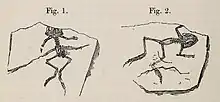Indobatrachus
Indobatrachus is an extinct genus of frog known from the Late Cretaceous (Maastrichtian) of India. It contains a single species, Indobatrachus pusillus.[1][2][3]
| Indobatrachus Temporal range: | |
|---|---|
 | |
| Illustration of fossil specimens | |
| Scientific classification | |
| Domain: | Eukaryota |
| Kingdom: | Animalia |
| Phylum: | Chordata |
| Class: | Amphibia |
| Order: | Anura |
| Suborder: | Neobatrachia |
| Genus: | †Indobatrachus Noble, 1930 |
| Species: | †I. pusillus |
| Binomial name | |
| †Indobatrachus pusillus (Owen, 1847) | |
| Synonyms | |
| |
Indobatrachus was a very small frog, only 20 millimetres (0.79 in) long as an adult. It is known from numerous complete but poorly-preserved specimens (known by Richard Owen as "batracholites") from the Intertrappean Beds of Worli Hill, Mumbai. The stratigraphy of the specimens was formerly dated to the Early Eocene, but is now thought to be Late Cretaceous in age. Two other species, I. trivialis and I. malabaricus, were also previously described, but these have since been synonymized with I. pusillus.[3][4][5]
The taxonomy of this genus is debated; it was previously classified within the Australian frog superfamily Myobatrachoidea by many authors, including Owen, but such a relationship is now considered dubious or untenable, with only some vertebral similarities linking the two groups.[4][5][6] Alternatively, it may represent a member of the superfamily Sooglossoidea, another ancient group that is thought to have originated on Insular India during the Cretaceous.[7]
References
- Owen (1847). "On the Batracholites, indicative of a small species of Frog ( Rana pusilla , Ow.). Addendum to the Communication from G. T. Clark, Esq., Bombay". Quarterly Journal of the Geological Society. 3 (1–2): 224–225. doi:10.1144/GSL.JGS.1847.003.01-02.24. ISSN 0370-291X. S2CID 130170290.
- "Fossilworks: Indobatrachus pusillus". www.fossilworks.org. Retrieved 11 May 2023.
- Metcalf, M. M. (12 December 1930). "A Fossil Frog, Indobatrachus Noble, from the Eocene of Southwestern India". Science. 72 (1876): 602–603. Bibcode:1930Sci....72..602M. doi:10.1126/science.72.1876.602. ISSN 0036-8075. PMID 17756365.
- Folie, Annelise (2012). "Early Eocene frogs from Vastan Lignite Mine, Gujarat, India". Acta Palaeontologica Polonica. doi:10.4202/app.2011.0063. ISSN 0567-7920. S2CID 55406707.
- Špinar, Zdeněk V.; Hodrová, Marcela (1985). "New knowledge of the genus Indobatrachus (Anura) from the Lower Eocene of India". Amphibia-Reptilia. 6 (4): 363–376. doi:10.1163/156853885x00353. ISSN 0173-5373.
- Tyler, Michael J. (1974). "First frog fossils from Australia". Nature. 248 (5450): 711–712. Bibcode:1974Natur.248..711T. doi:10.1038/248711b0. ISSN 1476-4687. S2CID 4206559.
- Biju, S. D.; Bossuyt, Franky (2003). "New frog family from India reveals an ancient biogeographical link with the Seychelles". Nature. 425 (6959): 711–714. doi:10.1038/nature02019. ISSN 1476-4687. PMID 14562102. S2CID 4425593.